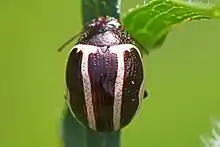Zygogramma suturalis
Zygogramma suturalis, commonly known as the ragweed leaf beetle, is a species of leaf beetle belonging to the genus Zygogramma.[1] Native to North America, it has been introduced into Russia and China for the biological pest control of ragweed.
| Zygogramma suturalis | |
|---|---|
 | |
| Scientific classification | |
| Kingdom: | |
| Phylum: | |
| Class: | |
| Order: | |
| Family: | |
| Genus: | |
| Species: | Z. suturalis |
| Binomial name | |
| Zygogramma suturalis (Fabricius, 1775) | |
| Wikispecies has information related to Zygogramma suturalis. |
Description

This leaf beetle is small with a brown head and pronotum, and yellow elytra marked with two wide margins of brown on each wing; one in the middle and one at the suture.
Distribution
Z. suturalis is native to Canada and the USA.[1]
It was introduced into Russia in 1978 in an attempt to control invasive Ambrosia artemisiifolia (common ragweed).[2] About 1500 specimens were originally released which had eliminated ragweed at the experimental control site by 1983. The success of Z. suturalis in Russia led to a population explosion with densities of up to 100,000,000 adults per square kilometre recorded subsequently.[3]
It was introduced to China as a biological pest control for ragweed in 1987.[4]
Lifecycle and habitat
Adults and larvae feed on Ambrosia artemisiifolia (common ragweed), A. psilostachya, and A. trifida.[5]
Overwintering adults began feeding in late April or early May of the following year, having emerged when ragweed seedlings were only 2–5 cm tall.[6] Larvae of the first or spring generation began feeding in mid-May or early June and most reached maturity by early July.[6] Larvae of the second or late summer generation were evident during the first two weeks of August.[6]
No complex courtship behavioural patterns have been observed in Z. suturalis; copulation most commonly takes place during the late morning or early evening and lasts from a few minutes to well over an hour.[6] Females lay between 145-563 eggs, over a period of 22–42 days.[6] Eggs are deposited in clusters of two or three on the underside of young ragweed leaves, usually near the leaf tip.[6]
Investigations in the USA showed that Z. suturalis had 2 generations a year,[6] but field investigations in China have shown that the beetle species could have up to 3 generations a year in that populations.[4] At 26±1 °C, the average lifespan of the adult female and male was 82.5 and 67.8 days respectively.[4] The mated females began laying eggs two weeks after emergence. Each female lays an average of 394 eggs.[4]
References
- "Zygogramma suturalis (Fabricius, 1775)". Integrated Taxonomic Information System. 2017. Retrieved 2017-02-23.
- Kovalev, O.V.; Reznik, S.Ya.; Cherkashin, V.N. (1983). "Specific features of the methods of using Zygogramma Chevr. (Coleoptera, Chrysomelidae) in biological control of ragweeds (Ambrosia artemisiifolia L., A. psilostachya D.C.)". Entomologicheskoe Obozrenije (in Russian). 62: 402–408.
- Reznik, S. Ya.; Spasskaya, I. A.; Dolgovskaya, M.Yu.; Volkovitsh, M.G.; Zaitzev, V. F. (2008). "The ragweed leaf beetle Zygogramma suturalis F. (Coleoptera: Chrysomelidae) in Russia: current distribution, abundance and implication for biological control of common ragweed, Ambrosia artemisiifolia L." (PDF). Proceedings of the XII International Symposium on Biological Control of Weeds. pp. 614–619.
- Wan, F. H.; Wang, R. (1989). "Biology of Zygogramma suturalis (F.) (Col.: Chrysomelidae), an introduced biological control agent of common ragweed, Ambrosia artemisiifolia". Chinese Journal of Biological Control. 5 (2): 71–75.
- Clark, S. M.; LeDoux, D. G.; Seeno, T. N.; Riley, E. G.; Gilbert, A. J.; Sullivan, J. M. (2004). Host Plants of Leaf Beetle Species Occurring in the United States and Canada (Coleoptera: Orsodacnidae, Megalopodiae, Chrysolmelidae exclusive of Bruchinae) (PDF). Coleopterists' Society. p. 257.
- Piper, Gary, L. (1975). "The Biology and Immature Stages of Zygogramma Suturalis (Fabricius) (Coleoptera: Chrysomelidae)". The Ohio Journal of Science. 75 (1): 19–24. hdl:1811/22261.